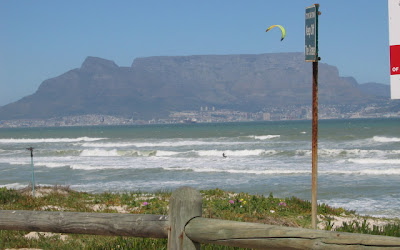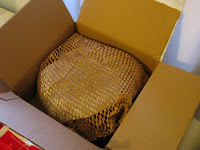Monday, October 15, 2007
A better life — right now
 I found out that today is Blog Action Day while reading through my feeds this morning — I've clearly been sleeping. So my small contribution for today is to try to amplify a simple and important message.
I found out that today is Blog Action Day while reading through my feeds this morning — I've clearly been sleeping. So my small contribution for today is to try to amplify a simple and important message.For a while I had been struggling with the whole message of global warming and climate change. The main reason was that the story was weak (in my opinion at least). Now what I mean by weak is that it was not changing enough lives — not creating enough action. I think Seth Godin managed to express the problem best.
The next step was figuring out the solution, which proved to be difficult. Thankfully I came across what I consider to be the best environmental blog I know of, No Impact Man, and in particular, this post.
"My point is that a big boost to the environmental cause might come with spending a little less time making people scared of a worse life and a little more time inspiring them towards a better one"Let us each start working towards a better life right now. We need to realise that the impact of our lifestyle is an event which is taking place now. We have real and immediate problems that need to be addressed, from children suffering from asthma due to exhaust fumes, to the depletion of fish stocks off the West coast of South Africa.
Take action to make a better world for yourself — right now.
Bonus Links:
- The City of Cape Town (my home - thanks to my wife for the photo above) published the "Smart Living Handbook" which has some excellent info and ideas.
- Lawn care for the cheap and lazy (I use these techniques on my own lawn).
- Gardening with indigenous South African plants.
Technorati tags : environment
Sunday, October 07, 2007
It's fill packaging, just better

I recently received some samples from Texas Instruments and was pleasantly surprised — actually blown away — by their fill packaging. Blown away by fill packaging? Let me explain...
Most of the fill packaging I have seen before normally involved polystyrene "chips" — basically plastic. What happens to those polystyrene chips normally? Well, expanded polystyrene is considered uneconomical to recycle[1] (in South Africa at least[2]) and ends up in landfills (or strewn around the countryside, waterways, etc.)
So I take out my samples and they are wrapped in paper — not just any paper, but a special expanded paper. Lucky for me, the manufacturer was smart enough to put their website onto the packaging: www.geami.com.
 Go check it out. It is paper with little slits cut into it. The slits cause the paper to expand when removed from the roll. This is a really great way to avoid bubble wrap, polystyrene chips, and other plastic packaging. They have some videos and cost comparisons that are worth checking out. If TI is using them for the free samples they ship all over the world (and most likely everything that they ship), then that alone must imply that this packaging is a good and viable option.
Go check it out. It is paper with little slits cut into it. The slits cause the paper to expand when removed from the roll. This is a really great way to avoid bubble wrap, polystyrene chips, and other plastic packaging. They have some videos and cost comparisons that are worth checking out. If TI is using them for the free samples they ship all over the world (and most likely everything that they ship), then that alone must imply that this packaging is a good and viable option.Other than the direct advantages of the Geami packaging, it can also be transported in its unexpanded form, which reduces the toll that transportation has on the environment.
The beauty of this product is that it is a simple and elegant packaging solution that is easily recyclable and improves not just the environmental friendliness of the packaging, but ALSO reduces the cost. A great example of engineering simplicity.
There are some other alternatives to polystyrene which are similar, but made from biodegradable compounds. It is hard to compare these with polystyrene because I do not know enough about them, but there are a couple of questions that come to mind (if anyone can answer these for me, please do):
- How do these products compare on cost?
- What is the impact of bioplastics on food prices? (I believe this is a big issue with biofuels and bioplastics)
- How recyclable are they? (recycling is generally better than allowing them to degrade in landfills)
[1]From The Plastics Federation of South Africa (scroll to the part about "The Plastics Recyling Sequence" and find polystyrene),
"The polystyrene mostly seen is the white, very light, friable, expanded or foamed polystyrene (PS-E). Although this material is recyclable it has such a large volume to mass ratio that it is completely uneconomical to transport and recycle at present."Also see polystyrene recycling on Isolite's website.
[2]Notice how expanded polystyrene products are absent from the list of recyclables for Cape Town, and on the non–recyclable side for Johannesburg.
Technorati tags : environment, recycling, waste, packaging, paper
Subscribe to:
Posts
(
Atom
)
Search This Blog
Subscribe
Tags
About this blog

I'm Duncan Drennan and this blog is about spreading ideas regarding engineering, our environment and creating a better world. You can also follow me on Google Reader.
About Engineer Simplicity
Engineer Simplicity specialises in the design and development of electronic products.
Copyright Notice
© Copyright 2006-2010, Duncan Drennan, All rights reserved
Popular Posts
-
The short version (my "elevator pitch"): Compact fluorescent lamps (CFLs) use about a fifth of the energy of a normal (incandescen...
-
As engineers we spend a lot of time solving problems. A customer has a problem and it needs to be fixed. The electronic boards you have just...
-
We are in the middle of an energy crisis and each of us need to make some dramatic changes to ensure that we have electricity, and that the ...
-
So here we are, the first blog post...well, really, here I am. My name is Duncan Drennan and this is my blog on business, design, electronic...
-
eWaste is a particularly difficult issue to deal with as it contains many different materials and lots of extremely hazardous substances. I...
-
There are a lot of steps to turn an idea into a product. Each step requires care and attention to ensure that the best product is created. B...
-
On 29 June 2009 my wife and I became parents to Grace Drennan. It is a great privilege, honour and responsibility to be a part of this amazi...
-
When James Bond used miniature cameras in the 60's and 70's the thought of a wireless phone that can take pictures and send them t...
-
Urban agriculture (UA) – the production of food within a city – is an important aspect of securing our food supply as well as restoring our...
-
This post forms a part of the SA Blook . So what is our reality? South Africa has an unemployment rate of about 23%, a skills shortage crisi...
© The Art of Engineering 2013 . Powered by Bootstrap , Blogger templates and RWD Testing Tool







